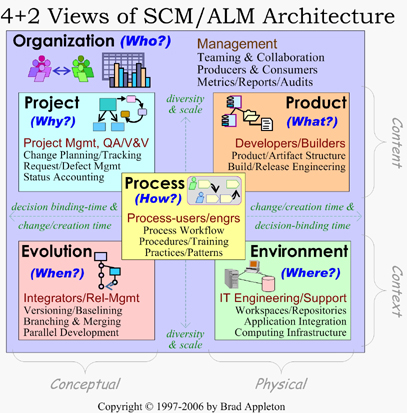The gist of the article was that it purported to have discovered some historical artifact whose wording resembled the July 1776 declaration of independence, but was referring to agile developers complaining about, and wanting freedom from, the so called "tyrannies" of many recurring heavyweight Software CM process implementations. Of course since it was posted in a forum for CM professionals, the article sparked some very strong reactions from some people (and you can read them in the "Balancing CM and Agility" thread if you like).
One thing regarding the article and discussion thread that struck me is very much related to one of the SCM Principles from GoF Design Patterns that I blogged about last week:
- Program to an Interface, Not an Implementation (a.k.a "Separate Interface from Implementation")
Some regarded the "National Treasures" article as an attack against CM and CM principles in general instead of taking it for what it was, a grievance with some commonly recurring characteristics of some heavyweight SCM process implementations.
That got me to thinking - maybe these could be recast as instances of violating an important SCM principle! Previously, I had blogged about "separating interface from implementation" as it applies to designing build scripts/recipes as well as CM processes and workflow. But I didnt really talk about how it applies to the roles involved in defining the CM activities and in executing the CM activities.
In the case of CM and development, I think it is frequently the case in many heavyweight SCM implementation, that the developers quite likely did not get a lot of say in defining the process and procedures they must follow to meet the needs of CM. It was instead defined primarily by configuration/build managers to meet needs needs like reproducibility, repeatability, traceability, and auditability without enough considerations to development's needs for:
- high quality+velocity acheived though rapid and frequent feedback that comes from very frequent integration (including being able to do their own merges+builds on their own "Active Development Line")
- unit, integration, and regression testing with the latest development state of the codeline
- effect fixes/changes quickly and efficiently without long wait/approval periods for authorization of changes they are likely to know need to be made ASAP (like most bugfixes and maintainability/refactoring changes found after the corresponding task was committed to the development codeline)
- Configuration Manage to an Interface, Not to an Implementation!
- CM (and other downstream stakeholders) should define their needs/requirements in terms of interfaces: policies, invariants, constraints, and entry criteria for what is given to configuration/build managers.
- Development should be empowered to attempt to define the implementation: the processes/procedures and conventions for how they will meet or conform to the "interface" needed by CM.
Does that mean every different development group that delivers to CM should be allowed to come up with their own process? What about having consistent and repeatable processes? If the requirements/interfaces are defined and repeatedly met, why and when do we need to care? Each development group is defining and repeatably executing its process to meet consistent CM entry-criteria. And doesnt the CMM/CMMI allow for project-specific tailoring of standard organizational processes?
Still, there should be some mechanism for a larger-grained collaboration, such as a so called "community of practice" for all the development projects to share their successful development practices so that that knowledge can be reused throughout the organization. And every time CM collaborates with yet another project, they can point to an existing body of development processes being successfully used that the project they are engaging might want to consider adopting/adapting.
I do think that if they (development + CM) choose to use a different process or significantly adapt an existing one, it would be good to know the differences and WHY they were necessary. Seems to me that matches the description of what an SCM Pattern is: something that defines a solution to an SCM problem in a context and captures the forces, their resolution, and the rationale behind it.
Then when CM and development work together the next time for the next project, they simply look at the set of SCM patterns they have been growing (into a pattern language perhaps) and decide which combination of patterns to apply, and how to apply them, to balance and resolve the needs of both CM and development, collaboratively!


